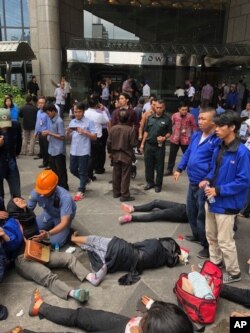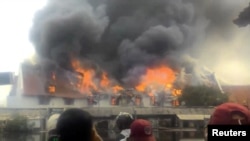A pair of unfortunate events transpired at two Jakarta buildings this week, one old and one new. On Monday, a floor at Indonesia’s stock exchange building collapsed, injuring 75 people. The very next day, a fire blazed at the historic Bahari museum, or Maritime Museum, in North Jakarta, which is housed in a historic Dutch building.
While the timing of the events was a coincidence, they may point to more widespread architectural woes in Jakarta, a city whose population has grown nearly 70-fold in the last century.
“Batavia, colonial capital of the Netherland Indies in 1900 was a small urban area of approximately 150,000 residents. In the first nationwide census of the Dutch colonial administration (1930), Jakarta’s population increased to 409,475. … Jakarta today has 10.2 million people and the peripheral area of Jakarta has more than 18 million people…. and it's beyond the original capacity of Batavia, a city planned by the Dutch colonial administration,” said Dr. Deden Rukmana, an urban studies professor at Savannah State University.
Stock Exchange
The Stock Exchange is housed in a modern tower built in the 1990’s in Jakarta’s financial district. A mezzanine floor collapsed on Monday, when a group of 92 students from Sumatra were visiting on a field trip. Their gathering in one place may have triggered the collapse, according to an initial report from the public works ministry, which suggested that the immediate cause was "loose or corroded bolts" or "shearing joints.” Many students were treated for concussions and broken bones at Jakarta hospitals, but there were no fatalities.
The incident shocked many observers because it took place in a modern, highly trafficked building in one of the wealthiest districts of Jakarta.
"It may be because of degradation of materials over time and because of earthquakes, and to prevent that we would have to develop more foolproof materials and connections,” Davy Sukamta, a civil engineer, told ABC News Australia.
“This is a lesson to not underestimate the standards and opinions of experts,” said Gunawan Tjahjono, an architect who heads Jakarta’s Building Experts Team. “The new GED is obliged to prioritize safety, security, health and comfort of users in addition to not having a negative impact on the surrounding environment, which includes congestion and flooding.”
Maritime Museum
In contrast to the Stock Exchange’s corporate tower in South Jakarta, the Maritime Museum is located in a 17th century warehouse complex built by the Dutch East India Company by the historic North Jakarta harbor. Reports say 60 percent of its artifacts were destroyed, none of them insured.
Jakarta governor Anies Baswedan said the museum’s artifacts, which include artifacts from and models of ships from different parts of Indonesia, are documented and that he hopes to commission replicas of them.
"It's certainly a great loss not only because of the contents of the museum but because of historic nature of the building and the whole Old Town area," said Isla Winarto, president of the Indonesian Heritage Society.
“With both the museum and the stock exchange, I feel it’s not an issue of infrastructure, but one of supervision, combined with disaster litigation,” said Elisa Sutanudjaja, of the RUJAK Center for Urban Studies in Jakarta. “For instance, with the museum, they just finished a renovation [in 2014], so why did this happen?”
She said better preparations were in order for historic buildings like those around the Jakarta harbor, especially since the city is subject to so many environmental factors beyond the disaster category, like flooding and heavy rains.
Like many other megacities from Mexico City to Manila, said Rukmana, Jakarta’s architecture needs to catch up to their rapid expansion. Going forward, he said, Jakarta city planners “need to apply green technologies and have regular inspections and strong law enforcement.”
Tjahjono echoed this sentiment: “We need to make sure that we put humans at the starting point of urban design.”









